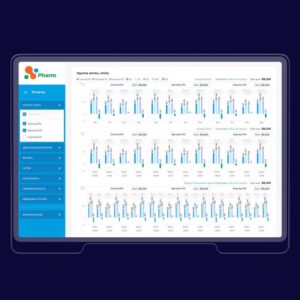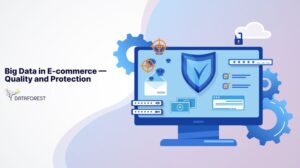- Home
- /
- Services
- /
- Data Science
- /
- AI Computer Vision
AI Computer Vision – Giving
Machines Super Sight
VOLTERA uses AI computer vision to teach computers to understand and create pictures or videos, which are moving pictures. We build tools that generate new images, improve existing ones, and extract information, leading to innovative computer vision applications in various industries.
Computer Vision is Unique
Unlike other forms of data, images, and videos are complex and rich in information. Computer vision extracts meaningful insights from this data, enabling previously unimaginable applications like object recognition, image generation, and video analysis. We provide computer vision consulting for your confidence.
Solutions of AI Computer Vision in Generative AI
Solutions for Specific Industries
Retail and E-commerce
- Visual Search: The solution allows customers to search for products using images instead of text. Computer vision algorithms analyze the image, identify objects, and retrieve similar products from the retailer’s inventory.
- Product Visualization: It generates high-quality product images, variations, and virtual try-ons using AI algorithms. This technology creates different product angles, colors, and styles and simulates how products look to customers.
- Inventory Management: AI uses computer vision services to automatically track inventory levels, identify products on shelves, and detect product placement issues. It also helps with product recognition for faster checkout and loss prevention.
- Personalized Recommendations: It analyzes customer behavior, purchase history, and visual preferences to recommend relevant products. Computer vision identifies products that customers are interested in based on images they view or products they wear.
Agritech and Food Production
- Crop Monitoring: Uses drones and satellites equipped with cameras to capture high-resolution images of fields. Computer vision algorithms study these images to identify crop health, detect pests and diseases, monitor soil moisture, and optimize nutrient application.
- Livestock Monitoring: Employ computer vision to track animal behavior, monitor their health, and detect signs of stress or disease. Cameras can be installed in barns and pastures to capture images and videos, which are then read by AI algorithms.
- Food Quality Inspection: Utilizes computer vision software to inspect food products for defects, contaminants, and quality attributes. AI algorithms classify products based on size, shape, color, and other visual characteristics.
- Supply Chain Optimization: Leverages computer vision to track products through the supply chain. Image recognition technology identifies product labels, packaging, and expiration dates. AI algorithms optimize transportation routes and inventory management.
Law Enforcement and Security
- Facial Recognition and Biometrics: Analyzes facial features to identify individuals in real time or from databases. It can also be used for biometric authentication, such as fingerprint or iris recognition.
- Object Detection and Tracking: Spots and tracks objects within a video stream, such as people, vehicles, weapons, or suspicious behavior. It can be used for surveillance, crowd control, and incident response.
- Image and Video Analysis: Studies visual data to extract information, such as license plate recognition, number plate recognition, and evidence gathering. It can also be used for crime scene analysis and forensic investigations.
- Crime Prevention: Reads crime data and patterns to predict potential crime hotspots and allocate resources accordingly. It can also be used for anomaly detection and suspicious activity identification.
Manufacturing and Industry 4.0
- Quality Control and Defect Detection: Uses computer vision software development to inspect products for defects, inconsistencies, or deviations from specifications. AI algorithms identify real-time issues, preventing defective products from reaching the market.
- Predictive Maintenance: Pinpoints images and video data from machinery to detect signs of wear and tear, potential failures, or anomalies. AI algorithms predict equipment failures before they occur.
- Supply Chain Optimization: Employs computer vision developers to track inventory levels, optimize warehouse layout, and improve logistics operations. Image recognition places product labels, barcodes, and packaging for efficient order fulfillment.
- Robot Guidance and Automation: Enables robots to perceive and interact with their environment using computer vision. AI algorithms process visual data to guide robots in picking, packing, assembly, and welding tasks.
Healthcare, Pharma, and Life Sciences
- Medical Image Analysis: Analyzes medical images such as X-rays, MRIs, and CT scans to detect abnormalities, tumors, or diseases. AI algorithms assist radiologists in interpreting images, leading to earlier diagnoses.
- Drug Discovery and Development: Inspects biological images, such as protein structures and cell interactions, to identify potential drug targets and accelerate drug discovery. Computer vision can also be used to optimize drug delivery systems and formulations.
- Surgical Assistance and Robotics: Provides real-time guidance to surgeons during procedures by overlaying digital patient anatomy information. Computer vision software development services can also be used to control surgical robots.
- Disease Surveillance: Examines images and videos from satellite imagery, social media, and medical records to monitor disease outbreaks and their spread. AI algorithms see patterns and anomalies that indicate potential health risks.
Logistics and Supply Chain
- Warehouse and Inventory Management: Uses computer vision to track inventory levels, optimize warehouse layout, and automate picking and packing processes. Image recognition can identify product labels, barcodes, and packaging for efficient order fulfillment.
- Freight and Package Inspection: Employs computer vision systems to inspect packages for damage, missing items, or security threats. AI algorithms recognize anomalies and potential issues, ensuring the integrity of shipments.
- Autonomous Vehicle Operations: Enables autonomous vehicles and drones to navigate complex environments, such as warehouses, distribution centers, and delivery routes. Computer vision is used for object detection, obstacle avoidance, and path planning.
- Supply Chain Visibility: Leverages computer vision to track products throughout the supply chain, from manufacturing to the end consumer. Image recognition points out product labels, barcodes, and packaging to create a digital record of product movement.
Want to see how AI can improve your business?
Voltera Success Stories: Generative AI in Action
Check out a few case studies that show why VOLTERA will meet your business needs.
Stock relocation solution
The client was faced with the challenge of creating an optimal assortment list for more than 2,000 drugstores located in 30 different regions. They turned to us for a solution. We used a mathematical model and AI algorithms that considered location, housing density and proximity to key locations to determine an optimal assortment list for each store. By integrating with POS terminals, we were able to improve sales and help the client to streamline its product offerings.

Client Identification
The client wanted to provide the highest quality service to its customers. To achieve this, they needed to find the best way to collect information about customer preferences and build an optimal tracking system for customer behavior. To solve this challenge, we built a recommendation and customer behavior tracking system using advanced analytics, Face Recognition, Computer Vision, and AI technologies. This system helped the club staff to build customer loyalty and create a top-notch experience for their customers.

Performance Measurement
The Retail company struggled with controlling sales and monitoring employees’ performance. We implemented a software solution that tracks sales, customer service, and employee performance in real-time. The system also provides recommendations for improvements, helping the company increase profits and improve customer service.

Supply chain dashboard
The client needed to optimize the work of employees by building a data source integration and reporting system to use at different management levels. Ultimately, we developed a system that unifies relevant data from all sources and stores them in a structured form, which saves more than 900 hours of manual work monthly.

Michelle Nguyen
Senior Supply Chain Transformation Manager Unilever, World’s Largest Consumer Goods Company
View case study →

Technologies of Artificial Intelligence and Machine Learning
Lama 2
Zilliz
Weaviate
Stable Difusion
Qdrant
Pix2Pix
Pinecone
Pgvctor
OpenAI
Momento
Mixtral
Llava
Hugging Face
Faiss
Chroma
ChatGPT
Activeloop
YOLO
SageMaker
Pillow
NLTK
Keras
SciPy
Redis
Observe how AI can boost your bottom line.
The AI Computer Vision Implementation Process
Figure Out the Problem
01
Gather Your Data
02
Clean Up Your Data
03
Teach Your AI
04
Make Your AI Smarter
05
Put Your AI to Work
06
Users' Feedback
06
Challenges Addressed by AI Computer Vision
We transform visual data into actionable insights through advanced algorithms that can process images and video at scale, enabling businesses to automate visual inspection tasks.
Quality Control Deficiencies
Security Vulnerability
Inventory Management Inefficiency
Quality Control Deficiencies
Security Vulnerability
Inventory Management Inefficiency
Customer Behavior Analysis Gaps
Benefits Of Cooperation with DATAFOREST
Partnering with us, a seasoned computer vision company significantly accelerates and optimizes the implementation of AI computer vision solutions.








